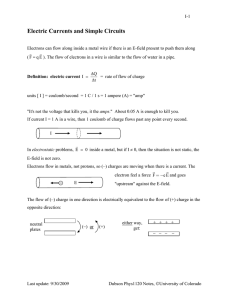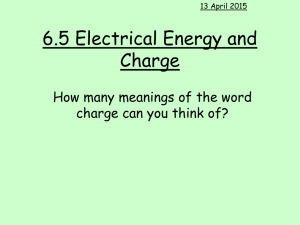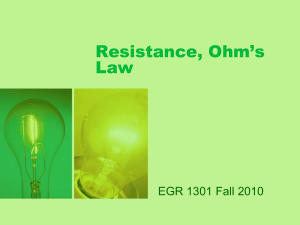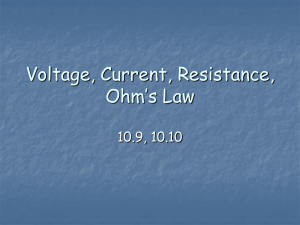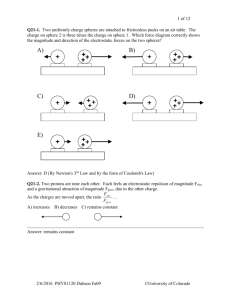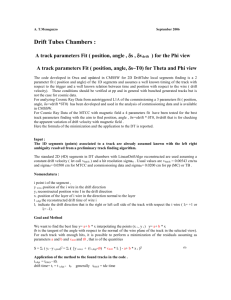ElectricCurrent - University of Colorado Boulder
advertisement
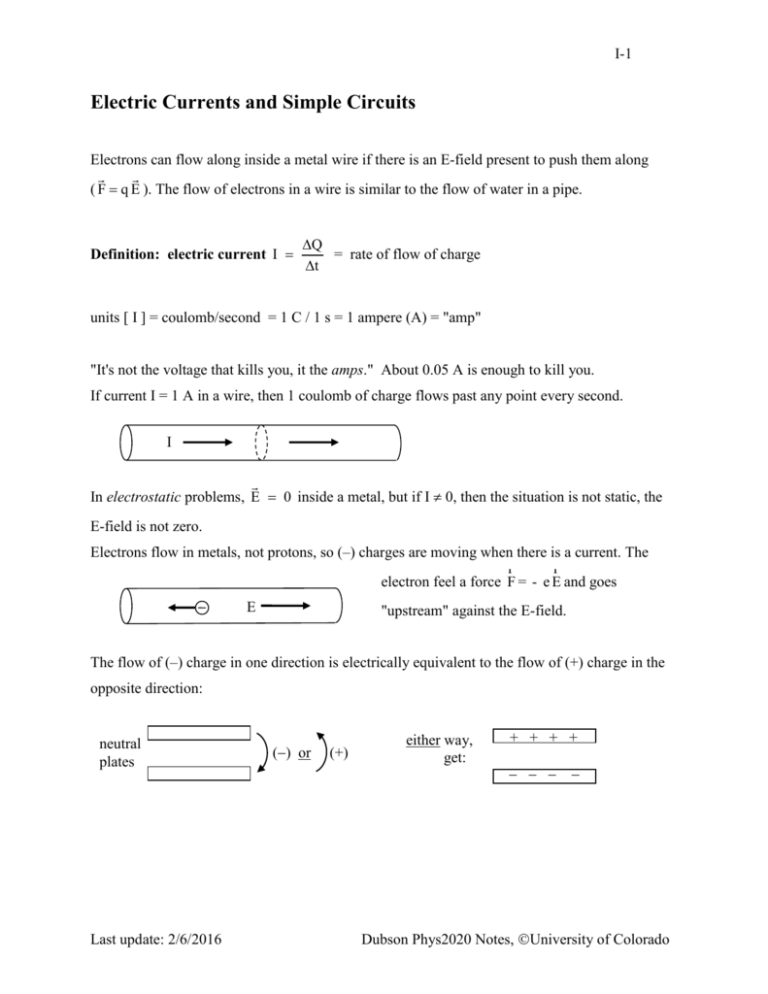
I-1
Electric Currents and Simple Circuits
Electrons can flow along inside a metal wire if there is an E-field present to push them along
( F q E ). The flow of electrons in a wire is similar to the flow of water in a pipe.
Definition: electric current I
Q
= rate of flow of charge
t
units [ I ] = coulomb/second = 1 C / 1 s = 1 ampere (A) = "amp"
"It's not the voltage that kills you, it the amps." About 0.05 A is enough to kill you.
If current I = 1 A in a wire, then 1 coulomb of charge flows past any point every second.
I
In electrostatic problems, E 0 inside a metal, but if I 0, then the situation is not static, the
E-field is not zero.
Electrons flow in metals, not protons, so (–) charges are moving when there is a current. The
r
r
electron feel a force F = - e E and goes
E
"upstream" against the E-field.
The flow of (–) charge in one direction is electrically equivalent to the flow of (+) charge in the
opposite direction:
neutral
plates
Last update: 2/6/2016
() or
(+)
either way,
get:
+ + + +
Dubson Phys2020 Notes, University of Colorado
I-2
By convention, we define current I as the flow of imaginary (+) charges, when it is really (–)
charges flowing the other way:
I
(Some texts refer to I as the "conventional current" to distinguish it from the "electron current".)
Example: How many electrons flow past per second when the current is 1 A?
I =
DQ
D N ×e
=
Þ
Dt
Dt
DN
I
1A
1C/s
=
=
=
= 5.6´ 1018 s- 1
- 19
- 19
Dt
e
1.6´ 10 C
1.6´ 10 C
About 0.01 A = 10 mA flowing though your heart is lethal, yet I could grab a wire carrying
1000A and be safe! Why? Because my body has a much higher electrical resistance than the
metal. The electrons prefer to flow through the metal wire.
For most materials, the current I is proportional to the voltage difference between the ends.
r
r
I µ E (since F = q E) and D V µ E, so I µ D V
lo V
hi V
E
I
V
From now on, we usually follow the (bad) convention and write "V" when we really mean "V".
I µ V ( really I µ D V) Þ
V
= constant
I
Definition of resistance R (of a piece of wire or other material): R º
V
I
The experimental fact that (for most materials) the ratio R = V / I is a constant, independent of V
or I, is called
Ohm's Law : R =
V
= constant , usually written
I
Units: [R] = volt / ampere = ohm ()
Last update: 2/6/2016
V= IR
(R constant)
["" is Greek letter omega]
Dubson Phys2020 Notes, University of Colorado
I-3
Ohm's Law should be written V = I R, but the bad convention is to write V = I R.
"Ohm's Law" is not really a law, because it is not always true. For many materials, Ohm's Law
is approximately true, the resistance R is approximately constant, independent of V or I.
Materials that obey Ohm's Law are called "ohmic materials". But some materials are "nonohmic"; they do not obey Ohm's Law.
The average speed of electrons in a current-carrying wire results from a competition between two
r
r
r
effects: (1) the E-field, which causes an acceleration according to F = q E = m a , making the
electrons go faster and faster, and (2) the scattering of electrons due to impurities and thermal
vibrations, which act like friction, making the electrons slow down.
For typical currents in real wires, the average electron speed (often called the drift velocity) is
actually quite slow, typically less than 0.1 mm/s. (Incidentally, the term drift velocity is incorrect,
it should be called the drift speed.)
A material with lots of electron scattering has a high resistance:
Rwire << 1 , Rhuman 105
I =
V
10 V
=
= 10- 4 A (harmless)
5
R
10 W
V
100 V
I =
=
= 10- 3 A (painful!)
R
105 W
10 V safe,
100 V dangerous !
The resistance R of a piece of material depends on its shape and composition.
R big
Shape: long and skinny
R small
short and fat
— just like the flow of water through a pipe. Long skinny water pipes resist flow of water.
Turns out that R µ
L
,
A
area A
L
so big L means big R, big A means small R
Last update: 2/6/2016
Dubson Phys2020 Notes, University of Colorado
I-4
R =
rL
A
(Greek letter "rho") = resistivity
( We show were this comes in the next section below.)
Resistivity depends on the material composition, not on the shape. is a measure of the
scattering of electrons in that material, like viscosity of fluid in a pipe. Big means lots of
scattering (friction), big resistance to flow.
Units: r =
A
L
{
×R
[ ] = [R] length = m
length´ length
length
material
use
Cu
1.7 10-8 m
house wiring
Al
2.7 10-8 m
power lines
W (tungsten)
5.3 10-8 m (cool)
light bulb filaments
60 10-8 m (hot)
Fe
9.8 10-8 m
not used in wiring
glass
10+10 m
electrical insulator
Microscopic view of Ohm's Law.
Definition: current density
J=
I
A
(current per area in a conductor). We also define current
density vector J where direction of J is the direction of the current.
J is related to the average speed vdrift of the charge carriers (usually electrons) by
J = n q vdrift
,
n is the number of carrier per volume, q is the charge per carrier (usually q = e).
Proof: Consider a wire with carrier density n (#/volume), cross-sectional area A, and drift speed
vdrift. In a time t, all the charges move an average distance x = vdrift t.
Last update: 2/6/2016
Dubson Phys2020 Notes, University of Colorado
I-5
volume = A x
area A
J
The charge Q in the length of wire x is
x = vdrift t
DQ =
number of carriers charge
´
´ volume = n q A D x
volume
carrier
So the current density is J =
I
DQ 1
n q A Dx
=
× =
= n q vdrift
A
Dt A
A Dt
Done.
In ohmic materials, the current density J is proportional to the electric field E
v
v
J = E , where the proportionality constant is called the conductivity.
The resistivity is defined as =
1
and so E = J.
J = E or E = J , where = 1/ = constant is the microscopic version of Ohm's Law. We
now show that this is equivalent to V = I R : Consider a cylindrical section of conductor,
length L, cross-sectional area A, with current density J, and E-field E.
Start with E = J , now multiply both sides by L and write J
A
J, E
L
as J = I / A. E L = L
we have D V =
defined the resistance R as R =
Ohm's Law V = I R, where R =
Last update: 2/6/2016
I
I
. Notice that V = E L. So
A
L
, or D V =
A
I R , where we have
L
. We have just shown that E = J is the same as
A
L
.
A
Dubson Phys2020 Notes, University of Colorado
I-6
A Simple Circuit
Some electrical circuits symbols:
resistor
R
switch
capacitor
C
E or V
battery
(+) side
(–) side
A battery's job is to maintain a constant voltage difference between its terminals. It acts like a
charge pump, pushing (+) charge inside the battery from the (–) side to the (+) side. This is the
direction that the charges don't want to go. The battery has to do chemical work to push the
charges "uphill" (toward higher electrostatic PE).
"10-volt battery" means voltage across battery = E or V (or just V) = 10 volts = 10 V. Hence
the confusing equation: V = 10 V, meaning "the voltage difference across battery is 10 volts".
switch open
switch closed
V = +10V
V = +10V
R = 50
(carbon
resistor)
battery
V = 0V
V
I
R
wire
V = 0V
Always assume that the wires connecting circuit elements have zero resistance R wire = 0 no
voltage change along the wire, since Vwire = I Rwire = I 0 = 0.
Current around the circuit is: I =
V
10 V
=
= 0.2 A
R
50 W
Recall that (+) charge tends toward low voltage. Can think of voltage as a kind of "electrical
pressure". Water in a pipe flows from high pressure to low pressure. Likewise, (+) charges in a
wire flow from hi V to lo V. In the water-pipe analogy, we can think of a resistor as like a
porous plug of gravel in the pipe. The gravel plug offers resistance to the flow of water, so we
need a large pressure difference to push the water through.
Last update: 2/6/2016
Dubson Phys2020 Notes, University of Colorado
I-7
If no pressure difference across a pipe plug, then no water flows.
If no voltage difference across a resistor, then no current flows.
I
flow
hi P
hi V
lo V
lo P
V = V = I R
gravel plug in water-filled
pipe
Inside a resistor, (+) charge flows from hi V lo V ("downhill")
Inside a battery, (+) charge flows from lo V hi V ("uphill").
Current I is the same in the battery and the resistor, just as water flow (in gallons per minute) is
same through pump and through gravel plug.
hi pressure
hi V
Pump
gravel
V
I
R
lo V
lo pressure
Electrical Power
When I is big, R gets hot because the flowing electrons are scattered friction.
Recall that power P = rate at which energy is transformed = rate at which work is done
P º
DW
joule
= 1 watt (W)
, [P] =
Dt
second
In a resistor, the rate at which electrostatic PE is converted into thermal energy (heat) is
P=IV
( really, P = I V )
If I = constant, then the average speed of electrons is constant KE = (1/2)mv2 = constant.
Last update: 2/6/2016
Dubson Phys2020 Notes, University of Colorado
I-8
When an amount of charge Q flows through a resistor in a time t, from the high V side to the low
V side, the change in PE of that charge is PE = Q V. The PE of the charge Q is decreased,
but KE = constant. Where did the energy go? Answer: into thermal energy
P =
æQ ö
D PE
= çç ÷
÷
{V = I ×V
÷×D
çè t ø
t
V
{
I
P = I V and V = I R P = I ( I R ) = I2 R or P = (V / R) V = V2 / R
3 equivalent expressions for power:
P = I V = I2 R =
V2
R
"100 W bulb" uses P = 100 W. Light bulbs and most other appliances (TV, coffee grinder) are
designed to work with voltage V = 120 V (really V = 120 V).
example of electrical power: What is the current through a 100 W light bulb? What is its
resistance (when on and hot).
I =
P
100 W
V2
=
= 0.83A , P =
V
120 V
R
Last update: 2/6/2016
Þ
V2
R =
=
P
2
(120 V)
100 W
= 144 W
Dubson Phys2020 Notes, University of Colorado
